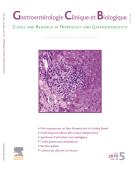Discordance between biochemical markers of liver activity and fibrosis (Actitest®–Fibrotest®) and liver biopsy in patients with chronic hepatitis C - 23/10/08
 , F. Bailly b, E. Trepo c, M. Chevallier d, M. Maynard-Muet b, B. Nalet e, S. Beorchia f, D. Pillon g, H. Moindrot h, B. Froissart i, M. Slaoui j, X. Tinel a, P. Pradat b, C. Trepo b
, F. Bailly b, E. Trepo c, M. Chevallier d, M. Maynard-Muet b, B. Nalet e, S. Beorchia f, D. Pillon g, H. Moindrot h, B. Froissart i, M. Slaoui j, X. Tinel a, P. Pradat b, C. Trepo bSummary |
Introduction |
The purpose of this clinical trial was to determine in routine practice and in comparison with liver biopsy the limitations of two blood tests, Actitest® and Fibrotest®, for the evaluation of hepatic activity and fibrosis in patients with chronic hepatitis C.
Methods |
Routine blood tests, Actitest® and Fibrotest®, and liver biopsy were performed in 96 patients with chronic hepatitis C attending routine outpatient clinics. Receiver operating characteristics (ROC) curves were used to assess the diagnostic value of the biochemical tests in comparison with the METAVIR classification.
Results |
The study population was predominantly male (63.5%) with a mean age of 48 years; 83.3% of the patients had genotype 1 hepatitis C virus infection. Treatment status was naive (62.5%), nonresponders (17.7%), relapsers (7.3%), or unknown (12.5%). The comparison of F0–F2 versus F3–F4 estimated the negative predictive value at 92% and the positive predictive value at 52% for a cut-off of 0.455. Discrepancies in activity score were more frequently due to a higher score of the biochemical test compared to biopsy (18 cases out of 19). Discrepancies for fibrosis were observed in 18 patients with a higher score for biochemical test in eight and a higher score for liver biopsy in 10 cases. A significant increase of gamma-glutamyl-transferase (GGT) (p=0.0001) and alanine aminotransferase (ALT) (p<0.0001) was observed in case of biochemical test overestimation of activity, and a significant increase of alpha2-macroglobulin (p=0.006) and GGT (p=0.018) in case of biochemical test overestimation of fibrosis.
Conclusion |
This prospective study confirms the good diagnostic value of biochemical tests for necrotico-inflammatory activity and fibrosis as compared with the histological analysis of liver biopsy. Clinicians must interpret Actitest® and Fibrotest® results with caution in patients with a significant elevation of ALT, and/or GGT and/or alpha2-macroglobulin which could overestimate hepatic injury.
Il testo completo di questo articolo è disponibile in PDF.Résumé |
Introduction |
Le but de cette étude prospective indépendante était d’identifier les limites éventuelles d’un test biochimique sanguin d’activité et de fibrose hépatique (Actitest®–Fibrotest®), comparé à la ponction-biopsie hépatique en pratique de ville.
Méthodes |
La comparaison de la performance de l’Actitest® et du Fibrotest® par rapport à la ponction-biopsie hépatique a été effectuée chez 96 malades atteints d’hépatite chronique virale C. La valeur diagnostique des tests a été analysée par courbe ROC.
Résultats |
L’âge moyen de la population, composée de 63,5 % d’hommes, était de 48 ans. L’infection par le virus de l’hépatite C était de génotype 1 dans 83,3 % des cas. Les malades étaient naïfs de tout traitement antiviral, répondeurs-rechuteurs et non-répondeurs dans respectivement 62,5, 7,3, 17,7 % des cas. Pour la comparaison F0–F2 versus F3–F4, la valeur prédictive négative du Fibrotest® était de 92 % et la valeur prédictive positive de 52 % pour un seuil de 0,455. Les discordances pour l’activité étaient liées le plus souvent (18/19 cas) à un score plus élevé pour l’Actitest® comparé à celui de l’histologie. Les discordances pour la fibrose étaient liées à un score plus élevé pour le Fibrotest® dans dix cas et pour l’histologie dans huit cas. Une augmentation significative de la gamma-glutamyl-transférase (GGT) (p=0,0001) et de l’alanine aminotransférase (ALAT) (p<0,0001) était observée en cas de score biochimique d’activité plus élevé et une augmentation significative de l’alpha2-macroglobuline (p=0,006) et de la GGT (p=0,018) était mise en évidence en cas de score biochimique de fibrose plus élevé.
Conclusion |
Cette étude confirme la bonne performance diagnostique de l’Actitest®–Fibrotest® par rapport à la ponction-biopsie hépatique. L’interprétation de ce test doit rester prudente en cas d’une augmentation marquée de l’ALAT et/ou de la GGT et/ou de l’alpha2-macroglobuline, celles-ci pouvant aboutir à une surestimation de l’inflammation et de la fibrose hépatique.
Il testo completo di questo articolo è disponibile in PDF.Mappa
Vol 32 - N° 10
P. 858-865 - Ottobre 2008 Ritorno al numeroBenvenuto su EM|consulte, il riferimento dei professionisti della salute.

